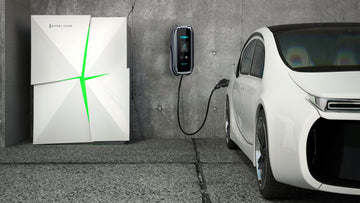Can Personal Installation of Electric Vehicle Charger Be Connected to Their Own Home Electricity?
Sep 19, 2023

New energy vehicles, often powered by electricity, rely on various types of charging infrastructure to replenish their energy reserves. Charging piles, sometimes referred to as EV chargers, serve as the electric refueling stations for these vehicles, offering the convenience and accessibility crucial for the widespread adoption of electric vehicles. Individual installation of new energy vehicle charging piles, including fast EV chargers, EV home chargers, and other EV charger types, can be seamlessly integrated into a driver's home electricity supply. To ensure a safe and efficient charging experience, it's important to pay attention to several key points.
Understanding EV Charging Infrastructure
Types of EV Chargers
-
Level 1 Chargers
- Overview: Level 1 chargers use a standard household outlet (120V) and typically deliver around 1.4 kW to 1.9 kW of power. They are the most basic type of EV charger and are often included with the purchase of an electric vehicle.
- Usage: Suitable for overnight charging or low daily mileage needs. These chargers can take several hours to fully charge a vehicle, depending on the battery size.
-
Level 2 Chargers
- Overview: Level 2 chargers operate at 240V and can deliver between 3.3 kW and 19.2 kW of power. They require a dedicated electrical circuit and are significantly faster than Level 1 chargers.
- Usage: Ideal for home installations, workplaces, and public charging stations including Tesla destination charger. They can fully charge most EVs in a few hours.
-
DC Fast Chargers (Level 3)
- Overview: DC fast chargers provide rapid charging by converting AC power to DC within the charger itself and delivering it directly to the vehicle’s battery. These chargers can deliver between 50 kW and 350 kW of power.
- Usage: Typically found at commercial locations and along major highways, they can charge an EV to 80% in about 30 minutes.
Key Considerations for Home Installation
1. Mind the Cable Specifications
Just as different power appliances require specific wire thickness and appropriate-sized circuit breakers to function safely, EV chargers also have their own requirements. Ensuring the correct cable specifications is crucial to avoid overheating and potential electrical hazards.
- Portable Chargers (1.7 kW): These can be easily plugged into any standard electrical outlet at home without causing adverse effects on the circuit or outlet. They are ideal for basic, low-power charging needs.
- Wall-Mounted Chargers (3.3 kW): These require a dedicated 2.5 square millimeter, 16A air conditioning line to ensure safety. This setup is common for many home installations and provides a balance between charging speed and electrical load.
- High-Power Chargers (7 kW and above): For more powerful 7 kW charging piles, the wire specifications should be at least 6 square millimeters. However, it’s important to note that most average households might not have this size of wiring pre-installed, so installation may require rewiring by a professional electrician.
2. Consider the Power Load
Household electrical circuits have a specific capacity, typically around 240V/200A. Overloading these circuits can result in tripping or even fire hazards. Therefore, when using home EV charger, especially high-power 7 kW variants, it’s crucial to estimate the total charging power being used simultaneously.
- Load Management: Assess the overall power consumption of your home to ensure that adding an EV charger won’t exceed the capacity of your electrical system. This might include calculating the power usage of appliances like air conditioners, heaters, and other high-draw devices.
- Dedicated Circuits: In cases where 7 kW charging piles are used, it’s advisable for consumers to consult with their local power supply department to request a dedicated power line. This ensures both EV charging and household appliances can operate safely without overloading the system.
3. Prioritize Proper Grounding
Given that new energy vehicle bodies consist largely of metal, following national regulations for proper grounding is essential. This precaution minimizes the risk of electric shock accidents and ensures the safety of both the vehicle and the user.
- Grounding Requirements: Ensure that the electrical system used for the EV charger includes proper grounding as per local electrical codes. Grounding provides a path for electrical faults to be safely discharged, protecting users from electric shocks.
- Professional Installation: It’s recommended to hire a certified electrician for the installation of your EV charger. They will ensure that all grounding and electrical safety measures are properly implemented.
4. Avoid Low-Lying Areas
Install charging piles at elevated locations to prevent water accumulation or flooding, particularly during heavy rainstorms. Placing charging infrastructure in low-lying areas can lead to damage and unsafe conditions.
- Location Selection: Choose a location for your charger that is not prone to water pooling. Elevated spots or those with proper drainage are ideal to prevent water-related damage.
- Protective Measures: Consider installing protective covers or enclosures for outdoor chargers to shield them from the elements. Weatherproofing can extend the life of your charging equipment and ensure it operates safely in various conditions.
5. Power Off and Lock After Use
Whether your charging pile is installed indoors or outdoors, it’s a good practice to power off and lock the unit after charging. This helps prevent accidental electric shock and ensures that the charger is not used by unauthorized individuals.
- Security Features: Many modern EV chargers come with built-in security features, such as locking mechanisms or remote access controls via mobile apps. Utilize these features to enhance safety.
- Routine Checks: Regularly inspect the charger for any signs of wear or tampering. Ensure that locks and security measures are functioning correctly to prevent unauthorized access.
Practical Steps for Safe Installation
Assessing Your Electrical System
Before installing an EV charger, evaluate your home’s electrical system to determine its capacity and suitability for the additional load. This assessment includes:
Electrical Panel Inspection: Check the main electrical panel to ensure it has enough capacity and available circuit breakers to support the EV charger. If the panel is outdated or fully utilized, you may needto upgrade it to accommodate the new load. Consulting a licensed electrician for this assessment is highly recommended.
- Load Calculation: Calculate the total electrical load of your household, including all appliances and the proposed EV charger. This helps in understanding whether your existing system can handle the additional load or if upgrades are necessary.
Selecting the Right EV Charger
Choosing the right type of EV charger for your needs is crucial. Consider the following factors:
- Charging Speed: Determine your daily driving needs and select a charger that matches those requirements. For instance, if you drive short distances daily, a Level 1 charger might suffice. However, for longer commutes or faster charging needs, a Level 2 EV charger is more appropriate.
- Installation Location: Decide whether you need an indoor or outdoor charger. Outdoor installations should be weatherproof and durable to withstand the elements.
- Future-Proofing: Consider future needs such as potential upgrades to your vehicle or additional EVs in your household. Investing in a higher-capacity Level 2 charger can be more cost-effective in the long run.
Professional Installation
Hiring a professional electrician for the installation of your EV charger is vital for safety and compliance with local electrical codes. Here’s why professional installation is recommended:
- Compliance with Codes: A licensed electrician ensures that the installation meets all local and national electrical codes, which helps in preventing potential hazards.
- Quality Assurance: Professional installers have the expertise to handle the complexities of electrical systems, ensuring that the charger is installed correctly and operates efficiently.
- Warranty and Support: Many EV charger manufacturers require professional installation to validate the warranty. Additionally, professional installers often provide ongoing support and maintenance.
Managing Your Home’s Power Supply
Once the EV charger is installed, it’s essential to manage your home’s power supply effectively to avoid overloading circuits. Here are some tips:
- Staggering Usage: Schedule high-power appliances to run at different times than your EV charger. For example, avoid running the washing machine, dryer, and EV charger simultaneously.
- Smart Chargers: Consider installing a smart EV charger that can optimize charging times based on your energy usage patterns and electricity rates. These chargers can schedule charging during off-peak hours, reducing the load on your home’s electrical system and saving on energy costs.
- Energy Monitoring: Use energy monitoring devices to keep track of your household’s energy consumption. These devices can provide insights into peak usage times and help you manage your electrical load more effectively.
Ensuring Safety and Efficiency
To maintain safety and efficiency in your EV charging setup, follow these additional tips:
- Regular Maintenance: Periodically inspect the charger and associated wiring for signs of wear, damage, or corrosion. Regular maintenance can prevent potential issues and ensure the charger operates at peak efficiency.
- Surge Protection: Install surge protectors to safeguard your EVCS and home electrical system from power surges. Surge protection is especially important in areas prone to lightning or frequent power fluctuations.
- Emergency Procedures: Familiarize yourself with the emergency shut-off procedures for your EV charger. Knowing how to quickly disconnect the charger in case of an emergency can prevent accidents and damage.
Understanding the Costs

Upfront Costs
The cost of installing an EV charger can vary based on several factors, including the type of charger, the complexity of the installation, and any necessary electrical upgrades. Here’s a breakdown of potential costs:
- Charger Unit: Level 1 chargers are generally the least expensive, while Level 2 chargers cost more due to their higher capacity and additional features. Fast chargers are the most expensive and typically used in commercial settings.
- Installation: Professional installation costs can vary widely depending on the complexity of the job. Factors such as distance from the electrical panel, the need for additional wiring, and the type of mounting (wall-mounted or pedestal) can affect the cost.
- Upgrades: If your home’s electrical system needs upgrades, such as a new electrical panel or dedicated circuits, these costs should be considered. Upgrading your system can be a significant expense but is often necessary for safe and reliable operation.
Long-Term Savings
While the upfront costs can be substantial, there are significant long-term savings associated with installing an EV charger at home:
- Lower Fuel Costs: Charging an EV at home is generally cheaper than refueling a gasoline vehicle. Electricity rates are often lower than gasoline prices, and off-peak charging can further reduce costs.
- Convenience: Having a home charger eliminates the need for frequent trips to public charging stations, saving time and effort.
- Increased Home Value: Installing an EV charger can increase the resale value of your home. As EVs become more popular, homes equipped with charging infrastructure are likely to be more attractive to buyers.
Environmental and Social Benefits
Reducing Carbon Footprint
Charging your EV at home, especially if paired with renewable energy sources like solar panels, can significantly reduce your carbon footprint. Here’s how:
- Renewable Energy Integration: Using solar panels to generate electricity for your EVSE charger can make your vehicle’s operation nearly carbon-neutral. This reduces reliance on fossil fuels and lowers greenhouse gas emissions.
- Energy Efficiency: Home chargers are typically more efficient than public charging stations due to shorter transmission distances and the ability to charge during off-peak hours, reducing strain on the electrical grid.
Supporting Sustainable Transportation
By installing an EV charger at home, you’re contributing to the broader adoption of electric vehicles, which supports sustainable transportation. Benefits include:
- Decreased Air Pollution: EVs produce zero tailpipe emissions, reducing air pollution and improving public health, especially in urban areas.
- Energy Independence: Increased use of EVs reduces dependence on imported oil, enhancing national energy security.
- Innovation and Job Creation: The growing EV market drives innovation and creates jobs in the manufacturing, installation, and maintenance of EV chargers and related infrastructure.
Installing an electric vehicle charger at home offers numerous benefits, from convenience and cost savings to environmental and social advantages. By understanding the types of EV chargers, adhering to safety guidelines, and ensuring proper installation and management of your home’s electrical system, you can enjoy a seamless and efficient charging experience. Whether you choose a Level 1, Level 2, or fast EV charger, integrating charging infrastructure into your home electricity supply is a practical and forward-thinking step toward embracing new energy vehicles. As the adoption of electric vehicles continues to grow, having a home charging setup will become an increasingly valuable asset for any household.




